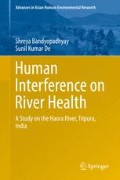Abstract
The Haora River basin is located in tropical monsoon climate that indicates hot and moist condition in summer and cold in winter seasons only. During summer, the temperature ranges between 25 and 29 °C, while during winter, the temperature reaches to 18–23 °C. The average annual rainfall of the study area is about 2500 mm, and that is mostly concentrated in the monsoon and late monsoon periods from June to September. The soil in the Haora River basin can be grouped into three distinct categories. These are (a) forest and hilly lateritic soil, (b) alluvial soil (younger and older) and (c) red loamy soil. The entire basin has a gentle slope except the eastern and southeastern part of the basin that is occupied by the Baramura range and other denudational hillocks. Geologically the basin possesses consolidated tertiary (Miocene-Bokabil and Bhuban Formations) sandstone and shale to unconsolidated quaternary sediments. Most of the younger sediments are highly fragile and susceptible to erosion. From the cross-sectional study of the river, it is observed that within the survey period, the river is experiencing changes in its physical and social condition.
Access this chapter
Tax calculation will be finalised at checkout
Purchases are for personal use only
References
Alam M (1989) Geology and depositional history of Cenozoic sediments of the Bengal Basin of Bangladesh. Palaeogeography, Palaeoclimatol Palaeoecol 69:125–139
Alam MS, Hossain MD (1998) Impact of river dynamics on coastal geomorphology: a case study on Feni River, Bangladesh. J Remote Sens Environ:2–20
Alam M, Alam MM, Curray JR, Chowdhury MLR, Gani MR (2003) An overview of the sedimentary geology of the Bengal Basin in relation to the regional tectonic framework and basin-fill history. Sedimentary geology of the Bengal Basin, Bangladesh, in relation to the Asia- Greater India collision and the evolution of the eastern Bay of Bengal. Sediment Geol 155:179–208
Bannert D, Helmcke D (1981) The evolution of the Asian Plate in Burma. Band 70(2):446–458
Bareh H (2007) Encyclopaedia of north-east India: Tripura, vol 8, 1st edn. Mittal Publication, Daryaganj
Barley ME, Pickard AL, Zaw K, Rak P, Doyle MG (2003) Jurassic to miocene magmatism and metamorphism in the Mogok metamorphic belt and the India–Eurasia collision in Myanmar. Tectonics 22(3):1019–1030
Bertrand G, Rangin C, Maury RC, Htun HM, Bellon H, Guillaud JP (1998) The Singu basalt (Myanmar): new constraints for the amount of recent offset on the Sagaing fault. Earth & Planet Sci 327:479–484
Curray JR (1991) Geological history of the Bengal geosyncline. J Assoc Explor Geophys XII:209–219
Curray JR, Munasinghe T (1991) Origin of the Rajmahal Traps and the 85 E Ridge preliminary reconstructions of the trace of the Crozet Hotspot. Geology 19:1237–1240
Department of Forest, Government of Tripura (DOFGT) (2013) Resource base. http://forest.tripura.gov.in/ResourceBase.htm. Cited on 12 Jan 2014
Guzman-Speziale M, Ni JF (1996) Seismicity and active tectonics of the western Sunda, The Tectonic Evolution of Asia. Cambridge University Press, New York, pp 63–84
Hall R (1997) Cenozoic plate tectonic reconstructions of SE Asia. In: Fraser AJ, Methews SJ, Murphy RW (eds) Petroleum geology of southeast Asia: aeological society of london special publication, 126, pp 11–23
Li C, van der Hilst RD, Meltzer AS, Engdahl ER (2008) Subduction of the Indian lithosphere beneath the Tibetan Plateau and Burma. Earth Planet Sci Lett 274:157–168
Mukhopadhyay M, Dasgupta S (1988) Deep structure and tectonics of the Burmese arc: constraints from earthquake and gravity data. Tectonophysics 149:299–322
Murphy RW (1988) Bangladesh enters the oil era. Oil Gas J 29(2):76–82
Ni JF, Speziale MG, Bevis M, Holt WE, Wallace TC, Seager WR (1989) Accretionary tectonics of Burma and the three dimensional geometry of the Burma subduction. Geology 17:68–71
Pivnik DA, Nahm J, Tucker RS, Smith GO, Nyein K, Nyunt M, Maung PH (1998) Polyphase deformation in a fore-arc/back-arc basin, Salin sub-basin, Myanmar (Burma). AAPG Bull 82:1837–1856
Sengupta S, Ray KK, Acharyya SK (1990) Nature of ophiolite occurrences along the eastern margin of the Indian plate and their tectonic significance. Geology 18:439–442
Tripurainfo (2013) Climate of Tripura (Cited on 29/11/2013). http://www.tripurainfo.com/info/ATripura/climate.htm
Uddin A, Lundberg N (1998) Unroofing history of the eastern Himalaya and the Indo-Burman ranges: heavymineral study of Cenozoic sediments from the Bengal Basin, Bangladesh. J Sediment Res 68:465–472
Author information
Authors and Affiliations
Rights and permissions
Copyright information
© 2017 Springer International Publishing Switzerland
About this chapter
Cite this chapter
Bandyopadhyay, S., De, S.K. (2017). Haora River Basin: Location and Geographical Background. In: Human Interference on River Health. Advances in Asian Human-Environmental Research. Springer, Cham. https://doi.org/10.1007/978-3-319-41018-0_2
Download citation
DOI: https://doi.org/10.1007/978-3-319-41018-0_2
Published:
Publisher Name: Springer, Cham
Print ISBN: 978-3-319-41017-3
Online ISBN: 978-3-319-41018-0
eBook Packages: Earth and Environmental ScienceEarth and Environmental Science (R0)

